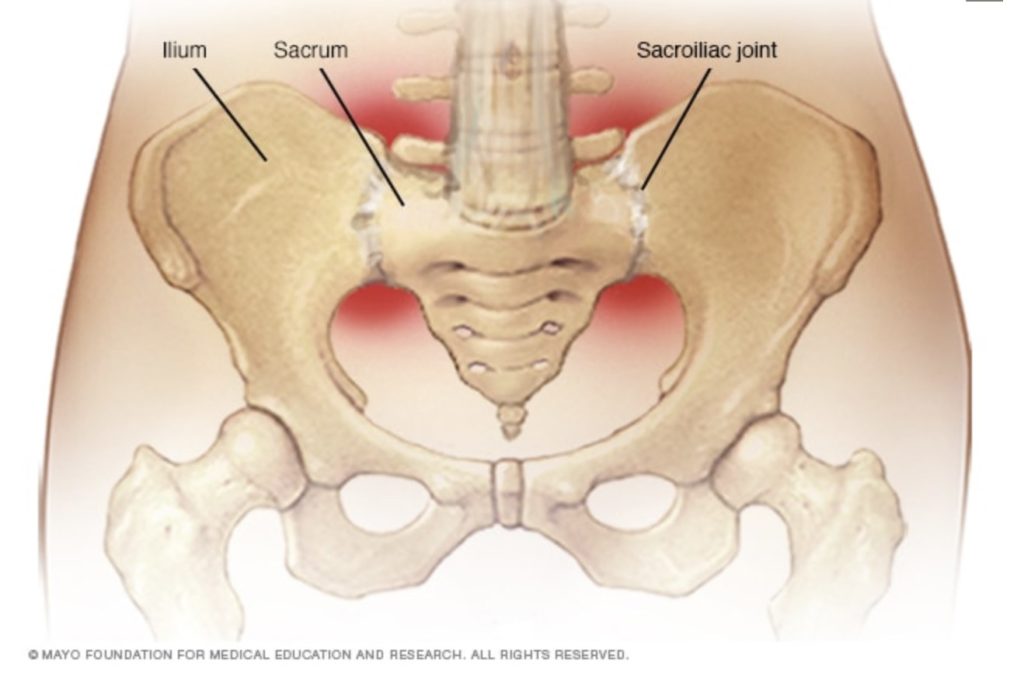What is the Sacroiliac Joint?
It is estimated that the sacroiliac joint is responsible for 15% – 30% of lower back pain cases today. Sacroiliac joint dysfunction is most common in young and middle-aged women. For example, women who are pregnant or have recently given birth may be more susceptible to sacroiliac joint pain. (spine-health).
The sacroiliac joints (or SI joints) are fundamental in providing stability for your body. They are responsible for transferring weight from the upper body to the lower body and stabilising the spine. The SI joints also help to rotate your hips, allowing you to bend forwards and backwards.
The SI joint is one of only two synovial joints (a type of joint found between bones), in our body – connecting the sacrum to the pelvis. See diagram below:

The sacrum (tailbone) connects on the left and right sides of the ilia (pelvic bones) to form your sacroiliac joints (or SI joints). Strong ligaments hold these joints in place.
What Causes Sacroiliac Joint Pain?
Sacroiliac joint pain can happen when there are sudden movements in one direction and then another direction too quickly, or if one of these joints has been injured due to an accident or fall.
Activities that require twisting or turning, such as golfing, dancing, and weightlifting can cause sacroiliac joint pain. Sitting for long periods of time, such as when driving or working at a desk can also lead to SI joint pain. This can be thought of as ‘too much movement or too little movement’. It can also be caused by a number of other factors including trauma, pregnancy, degenerative changes with age, and arthritis.
SI joint pain is a common source of low back pain, and can also cause pelvic pain, leg pain, or numbness in the legs. Pain in this area can be caused by:
– Tension in muscles surrounding the SI joint
– Muscle spasms
– Hypermobility or instability
– Structural problems such as a herniated disc
– Inflammation, such as an infection
What Does SI Joint Pain Feel Like?
Sacroiliac joint pain is characterised by pain in the middle or lower back, which may be worse when standing up straight or bending forward. It may also radiate around to the front of the hip and thigh. The severity of this pain can range from mild to severe and can be constant or intermittent.
Leg pain from sacroiliac joint dysfunction can be particularly difficult to differentiate from radiating leg pain caused by a lumbar disc herniation (sciatica) as they can often feel quite similar (spine-health). If pain is severe it is best to get an MRI before any planned treatment.
Sacroiliac joint dysfunction is the primary cause of 25% to 50% of significant chronic low back pain and should be corrected before considering surgery. (Practical Pain Management)
How to Prevent SI Joint Pain
Strong core muscles (transversus abdominis, and oblique abdominals), through their attachment to the iliac bones, help to stabilise the sacroiliac joints. Research has also shown that deep gluteal (buttock) muscles, if weak, affect your control of the sacroiliac joint. So keeping these muscles strong is key to preventing Sacroiliac Joint Pain.
Also if you have a tendency towards hypermobility be aware that you don’t overextend your joints during stretching and strength training.
What is the Best Treatment for SI Joint Pain?
As pain in the SI joint is often related to either too much motion or not enough motion in the joint, physical therapy such as myotherapy and remedial massage (including dry needling and trigger point therapy) target tight muscles within the hip-pelvis complex to help ease SI joint pain. Your therapist will also give you some suggested stretching and/or strengthening exercises depending on the cause of your pain.
Some wonderful exercises for SI joint pain are classic yoga poses such as cat-cow, child’s pose, pigeon pose and bridge pose (painteq). Always remember to synchronise your breathing with movement.
If you are experiencing symptoms of SI joint pain, first visit your GP to assess the underlying causes, then on the advice of your GP visit your physical therapist for targeted relief, and an ongoing treatment plan. A single appointment will most likely provide immediate relief but there is no magic bullet for chronic aches and pains. Long term improvements will happen only with ongoing therapy and an active treatment plan.
Book an appointment with a therapist today on 03 8598 9804 or online.